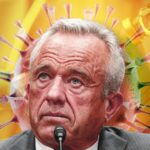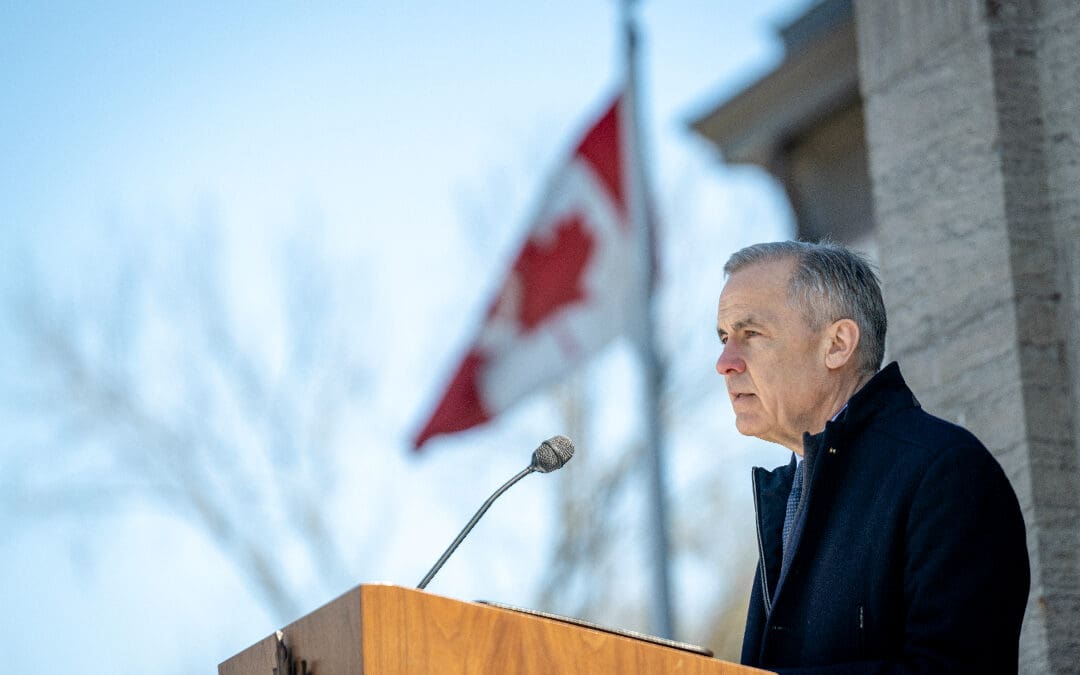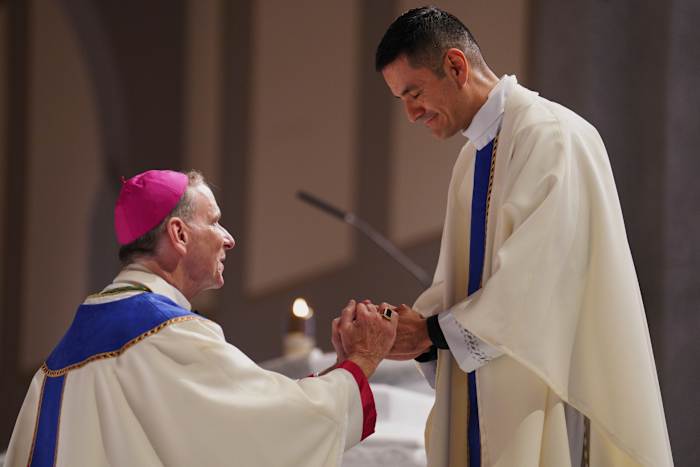
The NIH Moves to Stop Studying Vaccine Skepticism
March 26, 2025
Michael Weiss, Ben Smith, and Annie Karni: Radioactively Stupid
March 26, 2025
Just a few days after becoming prime minister, Mark Carney broke with tradition by making his first official trip abroad not to the United States — as is customary for Canadian leaders — but to Europe. The gesture was symbolic: a reaffirmation of Canada’s historic ties with Europe at a time of growing friction with its southern neighbor.
Carney visited Paris and London to underscore Canada’s deep friendships across the Atlantic as the country grapples with weeks of escalating trade conflict and political threats from Donald Trump, including tariffs and talk of annexation.
“I want to ensure that France and the whole of Europe works enthusiastically with Canada, the most European of non-European countries, determined like you to maintain the most positive possible relations with the United States,” Carney said after meeting the French president, Emmanuel Macron, in Paris. He then traveled to London for meetings with UK prime minister Keir Starmer and King Charles III.
The US-Mexico-Canada Agreement — once hailed by Trump as “the largest, most significant, modern and balanced trade agreement in history” — has given way to threats and economic pressure. Tariffs imposed by Trump have already harmed Canada’s economy, which is deeply integrated with that of the United States, and more levies are apparently on the table.
Trump’s aggressive posture has stirred a sense of national unity in Canada and given a boost to the Liberal Party, which until recently were trailing the Conservatives by a large margin. According to recent polls, Carney’s chances of winning the upcoming election have improved significantly.
Carney’s European tour was also an opportunity to demonstrate his stature on the international scene. In Macron, he found not just a diplomatic ally but an old acquaintance — one who helped cast Carney as an internationally respected leader at a pivotal moment. “Given that we’ve known each other for many years, I know that we are receiving a man who loves his country, who is committed to his country,” Macron said.
Canada’s ties to France and Britain run deep; the two countries led European settlement in Canada centuries ago. Carney also has personal ties to Britain: his wife is British, and in 2013 he became the first foreigner ever appointed governor of the Bank of England.
Canada and the European Union and have already deepened their ties through the Comprehensive Economic and Trade Agreement (CETA), which eliminated more than 99 percent of tariffs and helped boost trade by 25 percent, making Canada the EU’s twelfth-largest trading partner.
Still, the symbolic value of Carney’s European trip doesn’t alter economic reality. Canada’s relationship with the United States is irreplaceable. Roughly 80 percent of Canadian exports go to the US, with total trade between the two nations nearing $1 trillion.
By contrast, trade between Canada and Britain was worth about $43 billion last year. Canada’s trade with the broader EU bloc was more substantial, exceeding $100 billion and making the EU Canada’s second-largest trading partner.
Donald Trump has repeatedly threatened to annex Canada and turn it into the fifty-first US state, infuriating Canadians. Upon taking office, Carney firmly rejected this idea, as did his predecessor, Justin Trudeau.
These threats have become a central issue in the ongoing election campaign, altering the dynamic between Canada and its longtime ally to the south. Many Canadians have canceled trips to the US. In contrast, public interest in forging closer ties with Europe has soared, with the idea of Canada joining the European Union enjoying unprecedented popularity.
According to a February poll by Abacus Data, 44 percent of Canadians now believe their country should join the EU, compared to 34 percent who oppose the idea. Another question in the survey found that 46 percent would support accession, while 29 percent would be against it.
But could this actually happen? A spokesperson for European Commission president Ursula von der Leyen said the EU was “honored” by the survey results, seeing them as a sign of the union’s global appeal. However, they also pointed out that Article 49 of the Treaty on the European Union allows only European states to apply for membership — without defining what “European” actually means. The term has no fixed legal definition, leaving eligibility open to interpretation based on geography, history, and culture. Even so, the idea of Canada qualifying as a European state borders on the farcical — or, at best, represents a considerable stretch.
Another hurdle is membership in the Council of Europe, which Canada is not part of. Morocco, for instance, applied to join in 1987 but was rejected on the grounds that it is not a European country. Experts also note that accession could take ten to fifteen years and involve significant hurdles, from reconciling legal systems and agricultural standards to navigating differences in currency and regulatory frameworks.
Canada’s main defense alliance, the North Atlantic Treaty Organization (NATO), could face collapse in the coming months if Trump follows through with threats to withdraw the United States. Trump has also warned that he may expel Canada from the Five Eyes — the long-standing intelligence-sharing alliance among English-speaking countries formed during World War II.
In response to Trump’s return to the White House, both Canada and Europe are looking to reduce their dependence on the US, particularly when it comes to military hardware. Europe has moved quickly to ramp up its own military spending and capabilities in light of the instability caused by the Russian invasion of Ukraine. On March 4, the European Union officially launched its ReArm Europe plan.
Trump’s threats have also accelerated efforts by Canada to formalize a historic military partnership with the EU. Ottawa is nearing an agreement that would allow Canada to participate in the EU’s €800 billion rearmament initiative, slated for completion by 2030.
A recent European Commission white paper identified Canada — along with Norway and the UK — as key partners capable of strengthening the EU’s defense industry in the near term. “Our co-operation with Canada has intensified and should be further enhanced, also to strengthen transatlantic security,” the paper stated, adding that such partnerships would help launch “respective initiatives to boost defense industry production.”
Canada’s foreign affairs minister Mélanie Joly confirmed that talks are well under way. “This is very serious,” she said. “We’ve been in talks to work on defense procurement together. I went to Europe a month ago to make sure we could be a part of that partnership. . . . It’s yielding toward good news.”
Meanwhile, Canadian leaders are also looking to revive ties to historic allies like Australia, New Zealand, and the UK. Proponents of a CANZUK alliance say Canada’s political leaders should strike while the iron’s hot and immediately bolster trade links, integrate militaries to improve mutual defense, and pursue mobility rights for citizens — steps aimed at reducing reliance on an increasingly belligerent US. Taken together, the four countries would form a formidable bloc, with a combined GDP of roughly $6.5 trillion and the third-largest military force in the world.
This diplomatic shift has already led Carney to reconsider Canada’s $19 billion deal to buy eighty-eight F-35 fighter jets from US defense contractor Lockheed Martin. Although Canada has already paid for the first sixteen aircraft, scheduled for delivery starting next year, no contract has yet been signed for the remaining jets.
Instead, Canada is now looking at the Swedish company Saab as an alternate supplier. Saab came second in 2023 tender to replace the aging CF-18 fleet and had proposed building the plane in Canada — a plan the company said would create six thousand domestic jobs.
Europe isn’t the only potential ally for Canada. South Korea has offered to sell submarines, appealing to Canada’s plan to invest $100 billion in submersible acquisitions. But these military purchases come with high costs and must proceed alongside the country’s efforts to counter Trump’s tariffs.
Meanwhile, Trump has shown little interest in Canada’s right-wing populists, despite their clear efforts to align themselves with his political style. Instead, he has said that he would prefer to deal with Carney’s Liberals. Still, with the Canadian election campaign now underway — and Trump’s positions prone to abrupt shifts — it remains to be seen how all these cross-border dynamics will evolve.
Great Job Romain Chauvet & the Team @ Jacobin Source link for sharing this story.








